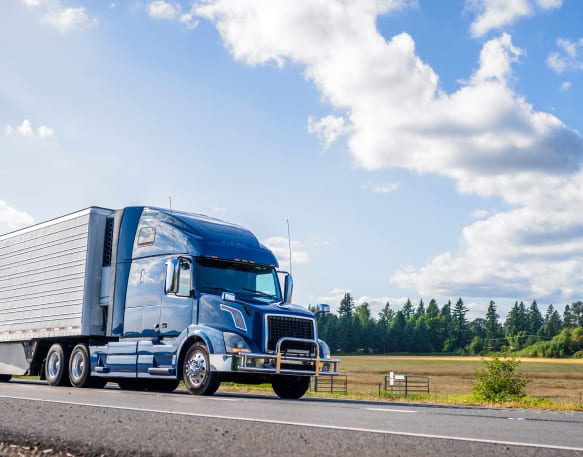
The ultimate guide to fuel efficient trucks: Benefits, features, and top models
This guide covers everything you need to know about fuel-efficient trucks, from the economic and environmental benefits to the top models available today. Explore key features like aerodynamic designs and advanced engines, learn practical tips for improving fuel efficiency, and discover the latest trends in hybrid, electric, and autonomous trucking technologies. Whether you’re a fleet manager or independent operator, we’ll help you make informed decisions to optimize your fleet and reduce fuel costs.
The best fuel-efficient trucks: Features and benefits
Fuel efficiency is more important than ever in the trucking industry. Fleet managers and owner-operators are turning to fuel-efficient trucks to stay competitive. While fuel-efficient trucks help reduce one of the largest expenses in trucking—fuel—they also improve vehicle performance and minimize downtime. Additionally, as the push for sustainability grows, fuel economy has become a major focus, leading to the development of cutting-edge, fuel-efficient truck models.
In this guide, we’ll explore the key benefits of fuel-efficient trucks, the features that set them apart, and some of the top models available today.
What are fuel-efficient trucks?
Fuel-efficient trucks are designed to minimize fuel consumption while maintaining high performance. These trucks focus on optimizing fuel economy, allowing drivers to cover more miles per gallon, which in turn helps reduce both operational costs and environmental impact. As the trucking industry grapples with rising fuel prices and increasing pressure to lower emissions, fuel-efficient trucks have become essential tools for both large trucking companies and individual owner-operators looking to stay competitive and sustainable.
The significance of fuel-efficient trucks goes beyond just cutting costs. For businesses that rely on transportation, fuel expenses can make up a substantial portion of their operating budget. By incorporating fuel-efficient trucks into their fleet, companies can reduce these expenses significantly, leading to better profit margins.
Benefits of fuel-efficient trucks
Fuel-efficient trucks offer numerous advantages, making them a smart investment in today’s competitive and environmentally conscious market. These trucks are designed not only to save money but also to help businesses comply with regulatory standards and reduce their environmental impact. Here are some of the top benefits:
Cost savings
One of the most significant advantages of fuel-efficient trucks is the substantial cost savings they offer over time. Fuel is one of the largest expenses for trucking operations, and driving habits—such as maintaining optimal speeds—play a critical role in maximizing fuel economy. By managing speeds effectively, fleets can reduce fuel consumption and increase efficiency, especially when covering thousands of miles each week. These savings quickly add up, improving profit margins for fleets and lowering expenses for independent operators, who can reinvest in their business or take home more earnings.
Regulatory compliance
While emissions standards and environmental regulations remain important considerations, potential changes may ease certain EPA requirements in the coming year. However, fuel-efficient trucks still offer significant benefits by helping companies maintain compliance with existing standards and prepare for any future regulatory shifts. Investing in these trucks ensures that trucking companies can adapt to regulatory changes while continuing to reduce costs and environmental impact, keeping their operations efficient and forward-thinking.
Enhanced performance
Modern fuel-efficient trucks are equipped with advanced technologies that enhance both performance and reliability. Features such as aerodynamic designs, lightweight materials, and efficient engine systems improve fuel economy while also contributing to better handling, smoother rides, and longer-lasting vehicle components. These trucks often come with advanced driver assistance systems (ADAS) that help optimize driving behavior for fuel savings, while also improving safety on the road. The combination of fuel efficiency and high performance makes these vehicles a powerful tool for any trucking operation looking to boost efficiency without sacrificing reliability or durability.
Key features of fuel-efficient trucks
Fuel-efficient trucks are designed with a range of technological advancements and engineering innovations that work together to minimize fuel consumption without sacrificing performance. These key features not only help reduce fuel use but also contribute to improved handling, durability, and environmental sustainability. Let’s take a closer look at the top features that enhance fuel efficiency in modern trucks:
Aerodynamic design
One of the crucial factors in improving fuel efficiency is reducing drag—and that’s where aerodynamics comes into play. Fuel-efficient trucks often have streamlined shapes, including rounded edges, smooth body panels, and features like side skirts and roof fairings. These design elements help the truck cut through the air more easily, reduce wind resistance, and maintain speed with less energy. By improving aerodynamics, trucks can achieve better fuel economy, especially during long hauls at highway speeds.
Lightweight materials
Reducing the weight of a truck is another critical component of fuel efficiency. Modern fuel-efficient trucks are built using lightweight materials such as aluminum, carbon fiber, or composite materials that decrease overall vehicle weight while still maintaining structural integrity. A lighter vehicle requires less power to move, which translates into less fuel consumption. By incorporating these materials into key components like the frame, wheels, and body, manufacturers can produce trucks that are both durable and fuel efficient.
Engine efficiency
At the heart of any fuel-efficient truck is an engine designed for optimal fuel combustion and energy use. Engine technology, such as turbocharging, direct fuel injection, and variable valve timing, helps maximize the amount of power generated from each drop of fuel. These engines are engineered to burn fuel more efficiently, reducing waste and delivering the same, if not better, performance while using less fuel. Additionally, many modern engines are built to adapt to different driving conditions, ensuring they operate at peak efficiency whether the truck is cruising on the highway or navigating through city streets.
Advanced transmissions
Fuel-efficient trucks often include advanced transmission options, such as automated manual transmissions (AMTs), which automatically select the optimal gear for the driving situation. AMTs are designed to reduce unnecessary revving, ensure smooth gear changes, and optimize engine power output. This can be particularly beneficial in stop-and-go traffic or hilly terrain. Additionally, AMTs help reduce driver fatigue by simplifying gear management, which can lead to more consistent fuel savings in specific applications.
At the same time, many owner-operators value the control and versatility of traditional 18-speed manual transmissions. With skill and experience, these drivers can also achieve excellent fuel efficiency by making precise gear shifts, especially in situations that demand greater control.
Fuel-saving technologies
In addition to improvements in engine and transmission design, modern trucks, particularly those used by larger fleets and mega-carriers, come equipped with a variety of fuel-saving technologies aimed at improving overall efficiency, such as:
- Start-stop systems: These systems automatically shut off the engine when the truck is idling, such as at stoplights or in traffic, and restart it when the driver is ready to move again.
- Predictive cruise control: This advanced cruise control system uses GPS data and real-time road conditions to optimize speed and fuel usage. By anticipating terrain changes, this technology adjusts speed to maximize fuel efficiency, though it is primarily found in trucks purchased by larger carriers.
- Energy recovery systems: Regenerative braking systems capture and store energy during braking, which can then power auxiliary systems or boost the engine. This cutting-edge technology is rarely seen in smaller fleets or among owner-operators but is becoming more prevalent in newer fleet trucks.
Top fuel-efficient truck models
With the growing demand for fuel efficiency, several truck manufacturers have developed models that prioritize both performance and fuel economy. These trucks are designed with advanced features to reduce fuel consumption while maintaining reliability, power, and durability. Below is an overview of the top fuel-efficient truck models currently available on the market.
Freightliner® Cascadia® Evolution
Freightliner’s Cascadia Evolution is widely recognized for its superior fuel economy, achieved through a combination of aerodynamic enhancements and cutting-edge engine technology. This model is powered by the Detroit® DD15 and DD13 engines, which are specifically designed to improve fuel combustion and reduce energy waste. The Cascadia Evolution features an aerodynamic design, including side fairings, roof deflectors, and chassis skirts, all aimed at minimizing drag and improving fuel efficiency on the highway.
Coupled with the Detroit DT12 Automated Manual Transmission, which optimizes gear shifts for fuel savings, this truck delivers a seamless and efficient driving experience. The integration of the engine, transmission, and axles ensures that energy loss is minimized, providing up to an 8% improvement in fuel efficiency over previous models. For companies that prioritize long-haul routes, the Cascadia Evolution offers both reliability and significant cost savings over time.
Kenworth T680 Next Gen
The Kenworth T680 Next Gen stands out for its exceptional fuel efficiency, driven by its sleek aerodynamic design and advanced powertrain. The PACCAR MX-13 engine is at the heart of this model, known for delivering high fuel efficiency without compromising performance. Paired with an automated transmission system, the T680 Next Gen ensures that gear shifts are precise and fuel-efficient.
Additionally, the truck is equipped with Predictive Cruise Control, a feature that uses GPS data to adjust speed and optimize fuel usage based on upcoming road conditions, such as hills and curves. This proactive approach to fuel management makes the T680 an industry leader in terms of long-haul fuel savings. For fleets that cover extensive distances, the Kenworth T680 Next Gen offers a powerful combination of fuel efficiency and dependable performance.
Peterbilt Model 579
Peterbilt’s Model 579 blends fuel efficiency with a focus on driver comfort and vehicle reliability. Powered by the PACCAR MX-13 engine, the Model 579 is engineered to optimize power output while minimizing fuel consumption, making it an ideal choice for both short and long-haul operations. A standout feature of this model is the SmartAir System, which uses 70% less fuel than diesel-based systems. This system is particularly beneficial during long stops, allowing for better fuel efficiency without sacrificing driver comfort.
The truck’s aerodynamic design, including roof and side fairings and an optimized bumper, further improves airflow and reduces drag, making it more fuel efficient at highway speeds. For trucking companies seeking a balance between fuel savings and robust design, the Peterbilt Model 579 is a top contender.
Tips for improving fuel efficiency in trucks
While investing in fuel-efficient truck models is a great start, truck operators can further enhance fuel economy by adopting practical strategies in their day-to-day operations. These tips not only help reduce fuel consumption but also extend the lifespan of the truck, improve safety, and lower overall operating costs.
Regular maintenance
A well-maintained truck operates more smoothly, consuming less fuel in the process. Key areas to focus on include the engine, tires, and filters. An engine that runs smoothly with clean oil and properly functioning components will burn fuel more efficiently. Equally important are the tires—under-inflated or poorly aligned tires increase rolling resistance, forcing the engine to work harder and burn more fuel. Additionally, replacing air and fuel filters as recommended ensures that the engine receives the clean air and fuel it needs to perform optimally. Scheduling regular check-ups and adhering to manufacturer maintenance guidelines will keep your truck in peak condition, ultimately saving fuel.
Driving techniques
Slowing down is the most important technique for improving fuel efficiency. Driving at lower, consistent speeds significantly reduces aerodynamic drag, which is one of the largest contributors to fuel consumption at highway speeds. Smooth acceleration is also crucial—rapid starts and aggressive driving can drastically increase fuel use. By anticipating traffic conditions and maintaining a steady pace, drivers can minimize unnecessary fuel burn. Sudden braking and acceleration, common in stop-and-go traffic, force the engine to work harder. Using cruise control on long stretches of road helps maintain consistent speeds, further optimizing fuel consumption. Additionally, reducing idle time, especially during prolonged stops, can greatly enhance overall fuel economy. Modern trucks with start-stop systems automatically manage idling, but manually shutting off the engine during long stops remains a simple and effective practice.
Load management
Proper load management is essential for optimizing fuel efficiency, but it’s not always within a driver’s control—especially at drop-and-hook shipper locations where trailers are pre-loaded. When possible, evenly distributing weight across the truck helps maintain balance, reduces strain on the engine, and improves aerodynamics. This not only enhances fuel economy but also boosts safety and handling. Even if the load is pre-arranged, ensuring it is properly secured is crucial, as a loose load can shift during transit, increasing drag and negatively affecting fuel efficiency.
Route planning
Choosing routes that minimize idle time, stop-and-go traffic, and frequent stops can help save fuel. For long-distance hauls, planning routes that avoid congested areas or times of day when traffic is heavy can reduce the amount of fuel wasted during idling. Additionally, using GPS and route optimization software allows drivers to find the most efficient routes, avoiding detours and roadblocks that can increase driving time and fuel consumption. Hills and mountainous terrain can also affect fuel usage, so selecting flatter routes when possible can further improve efficiency.
Role of fuel-efficient trucks in fleet management
For fleet managers, the adoption of fuel-efficient vehicles is not just about cutting costs; it also aligns with broader sustainability goals and helps ensure compliance with evolving regulations. Incorporating fuel-efficient trucks into a fleet can enhance overall performance, reduce environmental impact, and provide a competitive edge in an increasingly eco-conscious market.
- Cost management: By integrating fuel-efficient trucks into their fleets, managers can reduce fuel consumption across multiple vehicles, which translates into lower operating costs. Over the lifetime of a fleet, the cumulative savings from fuel efficiency can be considerable, allowing companies to reinvest in other areas of the business, such as vehicle maintenance, technology upgrades, or expanding operations.
- Sustainability goals: With fuel-efficient trucks, fleet managers can align their operations with broader corporate sustainability goals, enhancing the company’s public image and contributing to long-term environmental benefits.
- Compliance with regulations: While environmental regulations may shift in the coming years, compliance remains a key consideration for fleet managers. Fuel-efficient trucks are often designed to align with existing emissions standards, helping operators stay ahead of potential changes while maintaining operational flexibility.
- Improved fleet performance: Fuel-efficient trucks often feature aerodynamic designs, lighter materials, and engine systems that reduce drag and improve energy use, resulting in better fuel economy and lower operating costs.
Future trends in fuel-efficient trucking
As the trucking industry continues to evolve, the push for greater fuel efficiency is driving innovation across multiple fronts. Emerging technologies and alternative fuel sources are paving the way for a more sustainable and cost-effective future in transportation. Let’s take a look:
- Electric and hybrid trucks: Electric trucks, powered solely by batteries, are gaining traction as a zero-emission alternative to traditional diesel-powered vehicles. These trucks offer unparalleled fuel efficiency by eliminating the need for fuel altogether, drastically reducing operating costs and emissions. Hybrid trucks, which combine an internal combustion engine with an electric motor, represent a transitional solution. By using both fuel and electricity, hybrid trucks can improve fuel economy by supplementing the engine’s power during low-speed driving or idling, reducing fuel consumption while still offering the range and performance of traditional trucks.
- Alternative fuels: Alternative fuels such as compressed natural gas (CNG), liquefied natural gas (LNG), biodiesel, and hydrogen offer lower emissions and increased fuel efficiency compared to conventional diesel. CNG and LNG, for example, produce significantly fewer greenhouse gasses and pollutants, making them attractive options for companies looking to reduce their carbon footprint while maintaining operational efficiency.
The road ahead: Fuel efficiency as a strategic investment
Fuel-efficient trucks bring a host of long-term benefits, from saving money to supporting sustainability. As the trucking industry changes, investing in fuel-efficient models and smart strategies can cut operational costs and help meet regulatory standards. Whether it’s making the switch to electric trucks, exploring hybrid options, or optimizing routes, focusing on fuel efficiency is essential for effective fleet management. Plus, tools like the DAT One Load Board can boost efficiency even further, making sure every mile your trucks drive counts.
Share
Related Articles
FAQs
A few things you might be asking yourself
The truck with the best fuel economy varies based on factors such as load, route, and driving conditions. However, models like the Freightliner Cascadia Evolution, Peterbilt 579, and Kenworth T680 Next Gen are consistently ranked among the top for fuel efficiency. These trucks feature advanced aerodynamics, efficient engines, smart technology like automated manual transmissions (AMTs), and predictive cruise control to optimize fuel usage. Hybrid and electric options, such as Tesla’s electric semi, are also gaining attention for their exceptional fuel savings and environmental benefits.
Currently, no commercial trucks achieve 30 or 40 MPG. Most heavy-duty trucks, like the Freightliner Cascadia or Volvo VNL, typically reach around 6 to 10 MPG, depending on factors like speed and idling. However, advancements in fuel efficiency, such as improved aerodynamics, hybrid technologies, and electric trucks, are pushing the boundaries. Lighter vehicles like small pickup trucks or hybrid models may approach higher MPG figures, but for large commercial trucks, 30 to 40 MPG remains out of reach with today’s technology.
For commercial drivers seeking an economical pickup truck, the Ford Maverick Hybrid stands out as the top choice. With an impressive EPA-estimated fuel efficiency of 42 MPG in the city and 33 MPG on the highway, this compact hybrid combines utility with affordability. It’s an excellent option for those looking to save on fuel costs while still getting the job done.
Other economical alternatives include the Toyota Tacoma and the Chevrolet Colorado, which also offer respectable fuel economy for traditional gas-powered trucks. However, for commercial drivers focused on maximizing fuel savings, the Ford Maverick Hybrid currently leads the pack in the pickup truck market.
The best truck to start a trucking company depends on several factors, including your budget, skill set, and the type of hauling you’ll be doing. Consider whether you can perform your own repairs and maintenance, as this can influence whether you choose a newer truck with advanced technology or an older model with simpler systems. The terrain you’ll haul over, traffic density, and road types should also guide your decision. Ultimately, the ideal truck is one that fits your specific needs, offers manageable operating costs, and supports the long-term goals of your business.
Several factors influence a truck’s fuel efficiency, but slowing down is one of the most important techniques. Aerodynamic drag increases exponentially with speed, making higher speeds a significant contributor to fuel consumption. For every 10% reduction in drag, fuel efficiency can improve by approximately 5-7%. Driving at lower, consistent speeds—especially around 55 mph—can boost fuel economy by six to eight miles per gallon. Other factors include driving habits like smooth acceleration, load management, and terrain. Additionally, regular maintenance, such as proper tire inflation and engine tuning, ensures optimal performance and fuel savings.
Maximize every mile with the DAT One Load Board
Ready to make the most of your fuel-efficient truck? With the DAT One Load Board, you can easily find high-quality loads to keep your fleet running efficiently and profitably. Whether you’re an independent owner-operator or managing a fleet, pairing fuel savings with optimized load opportunities is a smart move.
Don’t leave money on the table—use the DAT One Load Board to maximize every mile and ensure your trucks are always on the road to success.




